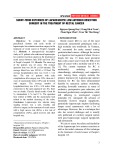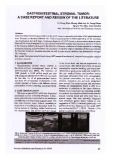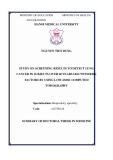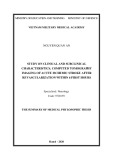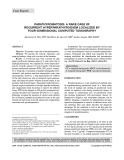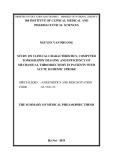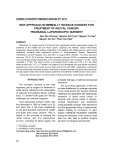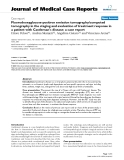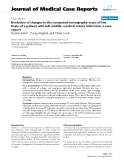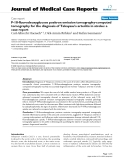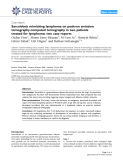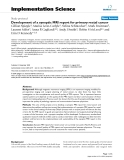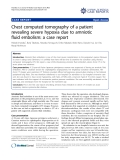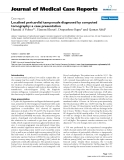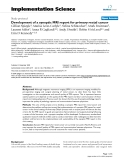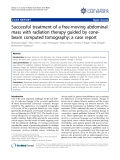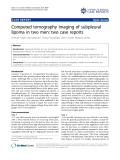Journal of military pharmaco-medicine no1-2019
NEW APPROACH IN MINIMALLY INVASIVE SURGERY FOR
TREATMENT OF RECTAL CANCER:
TRANSANAL LAPAROSCOPIC SURGERY
Ngo Tien Khuong1; Nguyen Anh Tuan2; Nguyen To Hoai2 Nguyen Van Du2; Pham Van Hiep2
SUMMARY
transanal
total mesorectal excision
in Gastrointestinal Surgery Department,
Objectives: To assess results of transanal total mesorectal excision laparoscopic surgery for treatment of the middle and low rectal cancer. Subjects and method: Clinical intervention, prospective, follow-up study without comparison in 45 patients with middle and low rectal cancer underwent 108 Millitary Central Hospital, from July 2017 to August 2018. Results: The mean operative time was 145.3 ± 22.5 minutes. Operative morbidity rate was 33.3%, no operative mortality. The macroscopic quality assessment of the resected specimen was complete in 77.8%, nearly complete in 17.8%. The mean number of harvested lymph nodes was 13.8 ± 6.7; the mean follow-up time was 7.47 ± 3.7 months, one patient (2.2%) developed local and distant recurrence, disease-free survival and overall survival rates was 97.7% and 100%, respectively. Conclusion: The transanal total mesorectal excision technique is feasible and safe, the good early outcomes, the high-quality of total mesorectal excision specimens for treatment in middle and low rectal cancer.
* Keywords: Rectal cancer; Transanal total mesorectal excision; Laparoscopic operation.
INTRODUCTION
lymphatic drainage, to optimize locoregional clearance.
The oncologic outcome is the most important goal in surgery for treatment of rectal cancer, followed by the preservation of sphincter and patients without artificial anus. To achieve both goals are still big challenges for colorectal surgeons.
tumour and
the mesorectum
Total mesorectal excision (TME) was first described in 1982 by Heald et al [1] and since then it has been established as the gold standard treatment of middle and lower third rectal cancers. TME is based on the principle of excising the rectal en bloc, including its blood supply and
The up to down approach of TME has not been satisfactory for oncologic outcomes in low rectal cancer [2]. Several technical challenges are associated with laparoscopic treatment of distal rectal tumors in patients with narrow pelvis or obesity. Limited visualization and insufficient maneuverability preclude safe dissections and the appropriate firing of laparoscopic staples leading to conversion to open surgery. Inadequate visualization, especially during the dissection of the anterior rectal wall may also lead to positive margins and poor oncological outcomes [3].
1. 105 Military Hospital 2. 108 Military Central Hospital Corresponding author: Ngo Tien Khuong (drkhuong.1978@gmail.com
Date received: 20/10/2018 Date accepted: 29/11/2018
90
Journal of military pharmaco-medicine no1-2019
* Surgical technique:
The first transanal TME (TaTME) resection assisted by laparoscopy was published in 2010 [4]. Since then, there have been publications demonstrating how this technique can be performed safely and preserves oncological TME principles [3, 5, 6, 7].
In this study, we report results of
45 patients in which TaTME assisted by laparoscopy for the resection of middle and low rectal cancer.
SUBJECTS AND METHOD
1. Subjects.
Forty-five patients with middle and low rectal cancer underwent TaTME in Gastrointestinal Surgery Department, 108 Millitary Central Hospital, from July 2017 to August 2018 were diagnosed with Tesla MRI 3.0; colonoscopy and biopsy and computed tomography (CT) of the thorax, abdomen and pelvis for staging were operated by TaTME.
chemotherapy with
the anterior and
to
Patients were placed in the Lloyd Davies position. The rectum was irrigated with iodine solution immediately before surgery. The procedure commenced with the perineal phase, a Lone Star Retractor System (Cooper Surgical Inc., Trumbull, Connecticut, USA) was used. For tumours located within 1 cm of the puborectal sling, a variable intersphincteric dissection with a hand-sewn coloanal anastomosis was performed. The intersphincteric dissection was extended cranially up to the level of the puborectal sling and the rectum was closed with a prolen 2/0 purse-string suture. After a washout with iodine solution, the GelPOINT Path Transanal Access Platform (Applied Medical, Inc., Rancho Santa Margarita, California, USA) was inserted, 3 airtight access channels (two 5 mm and one 10 mm) and an air inlet tube, through which the pelvic cavity was insufflated with CO2 to a pressure of 10 - 12 mmHg. After full thickness circumferential division of the rectal wall, the mesorectal plane was identified posteriorly in the 5 or 7 o’clock position allowing initial dissection the posterior plane before being in lateral extended aspects. Finally, the rectovaginal peritoneal reflection was identified and perforated to enter the peritoneal cavity.
Neoadjuvant chemoradiation was done in all patients with T3-T4 N0 or T1-T4N1-N2 tumors according the preoperative to staging. The protocol included a total dose of 50.4 Gy, with a daily dose of 1.8 Gy administered 5 days each week, continuous and infusion, 225 mg/m2/day, capecitabin during 5 days, concomitantly with radiation therapy. Following neoadjuvant repeat treatment, patients underwent staging with MRI before surgery at 6 - 8 weeks after the completion of radiotherapy.
2. Methods.
Clinical intervention, prospective, follow-up
We used 30-degree scope at the umbilicus with a 10-mm port, 12-mm and 5-mm ports at low right quadrant, 5-mm port at low left quadrant, and in some cases, a fifth port suprapubic. After division of the inferior mesenteric artery
study without comparison.
91
BMI, kg/m2, mean ± SD (range) 20.5 ± 2.5 (16 - 26.2)
the splenic
ASA score, n (%)
I 10 (22.2)
II 31 (68.9)
III 4 (8.9)
5 (11.1) Previous abdominal open surgery, n (%)
Tumor location, n (%)
Middle rectum 18 (40)
Lower rectum 27 (60)
Distance from anal verge by MRI (cm), mean ± SD (ranger) 4.6 ± 1.4 (2.2 - 8.2)
Preoperative T stage, n (%)
cT2 4 (8.9)
cT3 30 (66.7)
Journal of military pharmaco-medicine no1-2019 and vein, the left colon was completely mobilized, flexure was mobilized as well. TME was carried out up to down, according to the key principles of a correct oncologic surgical procedure. All the cases, the specimen was extracted the proximal margin was transanally, checked and a proximal resection of the specimen was performed using a pair of scissors at the anal verge level. Hand- sewn coloanal anastomosis was performed for patients with the lower rectal tumors and some patients with middle rectal cancer; stapled anastomosis was undertaken for patients with middle rectal tumors. A protective lateral ileostomy was performed when considered necessary. In all patients, a suction drain was placed in the deep pelvis.
cT4a 5 (11.1)
Not assessed* 6 (13.3)
Preoperative N stage, n (%)
Data analyses were performed applying the Statistical Package for the Social Sciences (SPSS, version 20).
cN+ 33 (73.3)
RESULTS
cN - 9 (20)
1. Patient characteristics.
Not assessed* 3 (6.7)
Preoperative M stage, n (%)
M0 43 (95.6)
laparoscopy were
included
in
M1 2 (4.4)
Forty-five patients with middle and low rectal cancer treated by TaTME assisted by the study.
Neoadjuvant therapy, n (%)
Table 1: Characteristics of patients in
the study.
Chemoradiation 15 (33.3)
Chemotherapy 1 (2.2) Data Characteristics
Radiotherapy 23 (51.1) Age, year, mean ± SD (range) 64.6 ± 11.0 (45 - 82)
Sex, n (%)
31 (68.9) Male
14 (31.1) Female
(*: MRI can not identify rectal cancer or lymph nodes postoperative metastatic chemoradiation; BMI: Body mass index; ASA: American Society of Anesthesiologists)
92
Journal of military pharmaco-medicine no1-2019
2. Perioperative outcomes.
Table 2: Perioperative data in patients undergoing TaTME for rectal cancer.
Data Characteristics
Abdominal access, n (%)
Laparoscopic LAR† 45 (100)
Intersphincteric resection, n (%) 9 (20)
Ileostomy, n (%) 32 (71.1)
Anastomosis, n (%)
Hand sewn 35 (77.8)
Stapled 10 (22.2)
Operative time (min), mean ± SD (range) 145.3 ± 22.5 (100 - 185)
72.7 ± 42.4 (30 - 225) EBL* (mL), mean ± SD (range)
Specimen extraction site, n (%)
Transanal 45 (100)
Intra-operative morbidity, n (%) 2 (4.4)
Bleeding 1 (2.2)
Rectal perforation 1 (2.2)
Postoperative complications, n (%), Clavien-Dindo classification 13 (28.9)
Urinary retention 7 (15.6) II
Bowel obstruction 2 (4.4) II
Anastomotic leakage 1 (2.2) IIIb
Rectovaginal fistula 2 (4.4) IIIb
Anastomotic bleeding 1 (2.2) I
Reoperation, n (%) 3 (6.7)
Length of stay (days), mean ± SD (range) 12.3 ± 6.1 (4 - 29)
Readmission, n (%) 6 (13.3)
(EBL: Estimated blood loss; LAR: Low anterior resection)
As shown in table 2, forty five patients (100%) underwent laparoscopic LAR with TME. The specimen was extracted transanally in all the cases. Most patients underwent a hand-sewn coloanal anastomosis (77.8%). Protective ileostomy was performed in 32 patients (71.1%). The mean operative time was 145.3 ± 22.5 minutes (ranged 100 to 185 minutes). Intra-operative complications occurred in two patients (4.4%), among which, one case involved in pelvic bleeding and one case had rectal perforation during the transanal dissection. There were no conversions and there was no perioperative mortality. Overall, 13 patients (28.9%) had postoperative complications.
93
Journal of military pharmaco-medicine no1-2019 Most patients (22.2%) were Clavien - Dindo grade I or II, 3 patients (6.7%) had major complications (Clavien - Dindo grade IIIb) underwent a reoperation, 2 patients had rectovaginal fistula required a permanent end colostomy and 1 patient (who had anastomotic leakage) was performed by transanal reinforcing stitches. The mean length of stay was 12.3 days and the readmission rate was 13.3%.
3. Histopathological results.
Table 3: Histopathologic characteristics of surgical specimens.
Characteristics Data
Quality of mesorectum, n (%)
Grade 3: complete 35 (77.8)
Grade 2: nearly complete 8 (17.8)
Grade 1: incomplete 2 (4.4)
T staging
T0 3 (6.7)
T1 1 (2.2)
T2 14 (31.1)
T3 24 (53.3)
T4 3 (6.7)
N staging
N0 30 (66.7)
N1 12 (26.6)
N2 3 (6.7%)
Number of lymph nodes, mean ± SD 13.8 ± 6.7
Tumour size (cm), mean ± SD 3.2 ± 1.7
Distal margins (mm), mean ± SD 23 ± 7
Positive 0
Proximal margin (cm), mean ± SD 11.9 ± 6.2
Positive 0
CRM positive⁑ 3 (6.7%)
(CRM: Circumferential resection margin)
A complete TME specimen was in 35 patients (77.8%). 2 patients (4.4%) were the TME incomplete. Most patients had a pT2 or pT3 tumour (84.4%). 15 patients (33.3%) had positive lymph nodes. The mean number of harvested lymph nodes was 13.8 ± 6.7. The mean distal margin was 23 ± 7 mm and none of distal margins were positive. CRM positivity rate was 8.9%.
94
Journal of military pharmaco-medicine no1-2019
4. Oncological outcomes.
Table 4:
Data Outcome
7.47 ± 3.7 Follow-up (month), mean ± SD
Recurrence, n (%)
42/43 (97.7) Disease free survival
1 (2.2) Local and systemic recurrence
0 (0) Port site recurrence
Survival, n (%)
45 (100) Alive
0 (0) Dead
There were no patients of local recurrence, 1 patient with distant metastasis at
6 months after the initial surgery. There were no port-site recurrences. At the end of follow-up, no patients died.
5. Functional outcomes.
Table 5: Sphincter function outcomes.
According to Kirwan’s classification
Total Kirwan I (very good) Kirwan II (good) Kirwan III (fair) Kirwan IV (bad) Kirwan V (very bad)
0 < 1 month 0 3 (18.8) 13 (81.2) 0 16 (100)
0 1 - < 3 months 1 (4.2) 18 (75) 5 (20.8) 0 24 (100)
0 3 - < 6 months 11 (50) 9 (40.9) 2 (9.1) 0 22 (100)
6 - < 9 months 6 (37.5) 7 (43.7) 3 (18.8) 0 0 16 (100)
9 - < 12 months 5 (71.4) 2 (28.6) 0 0 0 7 (100)
> 12 months 1 (100) 0 0 0 1 (100)

